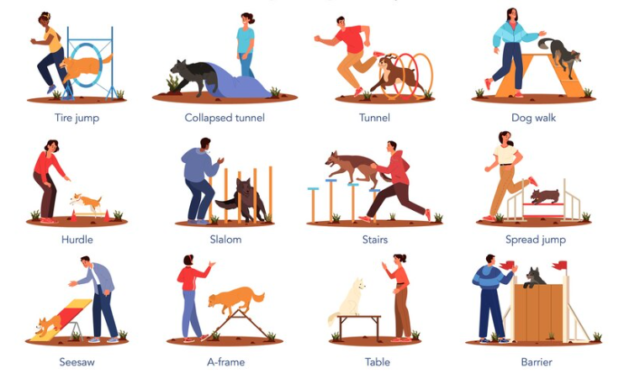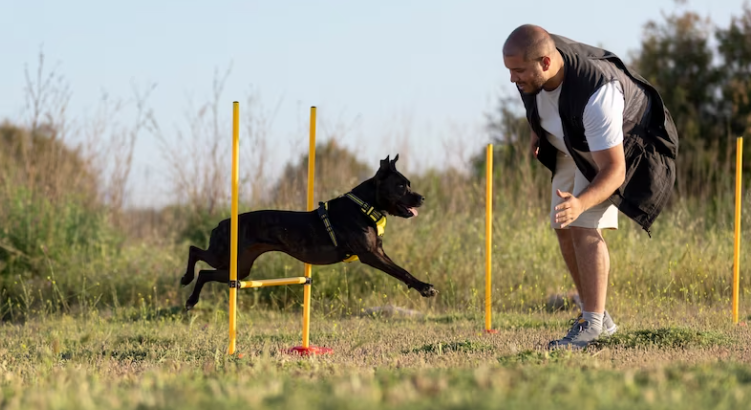The phrase “man’s best friend” frequently refers to dogs and for good reason. We receive unending love, devotion, and friendship from our animal friends. A deep link with your dog, however, takes time and work, just as in any other relationship. With dog trainings, you may improve your relationship with your dog.
The significance and advantages of dog trainings, various training modalities, fundamental and advanced training strategies, advice for effective training, and frequent pitfalls to avoid are all covered in this article.
Definition and Importance of Dog Trainings
The practice of teaching your dog certain habits or activities on command is known as dog training. It is impossible to exaggerate the benefits of dog training. Since they are more likely to get regular exercise and have a closer relationship with their owners, well-trained dogs are happier and healthier. Also, training guarantees that your dog will act properly and safely around other people and animals.
Benefits of Dog Training
The benefits of dog training are numerous. Some of these benefits include:
- Better communication between you and your dog
- A stronger bond between you and your dog
- Increased confidence and obedience in your dog
- Improved behavior in social situations
- Increased physical and mental stimulation for your dog

Types of Dog Trainings
There are several types of dog training methods, including:
- Positive Reinforcement Training – Reward-based training that focuses on positive reinforcement for good behavior.
- Clicker Training – A form of positive reinforcement training that uses a clicking sound to indicate when a dog has performed a desired behavior.
- Alpha Dog Training – A dominance-based training method that emphasizes the owner’s role as the “alpha” or leader of the pack.
- Electronic Collar Training – A controversial training method that uses an electronic collar to provide a shock or vibration to a dog as a form of punishment.
Choosing the Right Dog Trainings Method
The personality and behavior of your dog should be taken into account while choosing a training approach. Positive reinforcement works better on certain dogs than it does on others, who may need more forceful training techniques. It’s crucial to decide on your training objectives, such as beginning obedience or advanced competitive training, and to conduct your study and choose the best training approach for your dog.
Basic Dog Training Techniques
Some of the most common basic dog training techniques include:
- Sit and Stay Command – Teach your dog to sit and stay on command.
- Come When Called Command – Teach your dog to come when called.
- Heel Command – Teach your dog to walk on a leash without pulling.
- Down Command – Teach your dog to lie down on command.
- Off Command – Teach your dog to stop jumping up on people.
Advanced Dog Training Techniques
For those interested in taking their dog’s training to the next level, there are several advanced dog training techniques to consider:
- Training for agility involves teaching your dog to negotiate challenges like jumps, tunnels, and weave poles.
- Training for Obedience Competitions – Getting your dog ready for contests that judge a dog’s ability to obey directions and exhibit particular behaviors.
- Training your dog as a therapy dog would enable it to offer comfort and company to patients in healthcare settings like hospitals and nursing homes.
Tips for Successful Dog Trainings
No matter what type of training you choose for your dog, there are a few tips to keep in mind for successful training:
- The actions you want your dog to acquire should be continuously practiced since repetition is the best learning method for dogs.
- The most successful method for training a dog is reward-based training, often known as positive reinforcement. When your dog exhibits desirable behavior, reward them with treats, toys, or praise.
- Patience and endurance are necessary while training a dog. Expect your dog to take some time to pick up new skills, and be ready to overcome obstacles.
- Recognizing your dog’s limitations – Each dog is unique, and some may have trouble with particular habits. Realistic expectations of your dog’s capabilities and limits are crucial.
Common Dog Training Mistakes to Avoid
When it comes to dog training, there are also some common mistakes to avoid:
- Punishing your dog for mistakes – Punishment is not an effective training method and can damage the bond between you and your dog.
- Inconsistent training – Inconsistency can confuse your dog and make it harder for them to learn.
- Skipping steps in the training process – It’s important to start with basic behaviors and build up to more complex behaviors. Skipping steps can result in a poorly trained dog.

Conclusion
In conclusion, training your dog is a crucial part of dog ownership. Well-trained dogs are more content, more secure, and more healthy. There are numerous various training methods and approaches to take into account, whether you’re teaching your dog fundamental obedience or getting them ready for advanced competition. Spending the effort to teach your dog can strengthen your relationship with your four-legged friend and guarantee that you have a long, happy life together.
FAQ
-
What age is ideal to begin training a dog?
A: While some experts advise delaying basic obedience training until puppies are 12 to 16 weeks old, puppies can start as early as 8 weeks old. But, no matter how old your dog is, it’s never too late to begin teaching them. -
What faults should you try to avoid wHow long does training a dog take?hen teaching your dog?
A: Avoiding blunders like penalizing your dog for missteps, implementing inconsistent training methods, and skipping training phases are all frequent practices. Successful dog training relies on consistency and positive reward. -
How long does training a dog take?
A: A number of variables, including the dog’s age, breed, personality, and the sort of training being done, affect how long it takes to teach a dog. While advanced training might take many months or more, basic obedience training can take a few weeks to a few months. -
What are some pointers for effective dog training?
A: For successful dog training, remember to practice consistency and repetition, use reward-based methods, be persistent and patient, and be aware of your dog’s limitations. -
What advanced dog training methods are there?
A: Agility training, obedience competition training, and therapy dog training are a few examples of advanced dog training methods. Although they call for more effort and time, these methods may be incredibly rewarding for both you and your dog.
-


